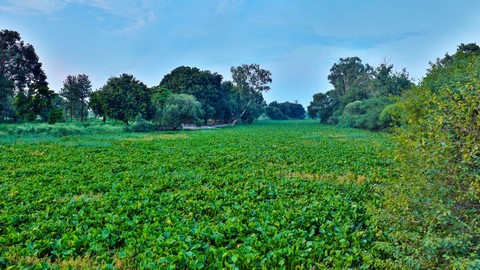1. Harike Wildlife Sanctuary
- Harike is the largest wetland in northern India in the Tarn Taran District of the Punjab State in India.
- The wetland and the lake were formed by constructing the head works across the Sutlej rivers, in 1952.
- The rich biodiversity of the wetland with its vast concentration of migratory waterfowls including a number of globally threatened species has been responsible for the recognition accorded to this wetland in 1990, by the Ramsar – 15 – Convention, as one of the Ramsar sites in India, for conservation, development and preservation of the ecosystem.
Location :
District Tarn Taran, Ferozepur & Kapurthala Access : 55 km, South of city of Amritsar Latitude : 31˚13’ N; 75˚2’ E Longitude : 75˚12’ E Altitude : 218.83m above MSL Flora : 24 terrestrial and 14 aquatic taxa including Najas, Hydrilla, Ipomoea, Azolla sp., Potamogeton, Vallisneria etc. Fauna : 16 Taxa (72 species) of Fishes, 6 Taxa of Frogs and toads, 7 species of Turtles (including IUCN Redlist Testudines Turtles), 13 species of Mammals (including Smooth Indian Otter and Indus River Dolphin), 391 species (59% Migratory) of Birds and 4 species of Snakes
Historical Importance:
- The presence of many Gurudwaras in the vicinity of the Wetland gives testimony to the legend that on the advice of Sri Guru Nanak Dev Ji, the sacred Rabab was taken by Mardana from Bharoana.
- Gurudwara Rabasar Sahib, Gurudwara Ishar dham etc are some of the well known gurudwaras.
2. Nangal Wildlife Sanctuary
Introduction
- Nangal Wetland is a unique habitat on account of its pristine blue-green water which is a excellent habitat for migratory and resident birds and other aquatic flora and fauna.
- Recently a group of Sarus cranes were spotted in this area.
- The landscape of the area is a mixture of hilly terrain and plain land with a huge water body covered with good number of trees, grasses and shrubs.
- The place is very well connected and lies close of Gurudwara Bhabour Sahib.
Location:
District Ropar Access : Nearest town/city is Nangal. Latitude : 31˚ 23’ Longitude : 76˚ 31’ Altitude : 362.71m Flora : The main tree species are Acacia nilotica, Cassia fistula, Magnifera indica, Syzygium cuminii, Acacia catechu, Ficus bengalensis, Ficus religiosa, Salix species etc. Fauna : 9 species of mammals such as Pale hedge hog, Jungle cat, Mongoose, Rufous tailed hare etc., 35 species of fishes, 154 species of migratory as well as resident birds.
3. Keshopur Community Reserve, Gurdaspur
Introduction
- The reserve comprises of 850 acre area of fresh water marshes (natural wetlands) comprising of two bits. Major bit is located adjoining to Miani, Dalla, Keshopur and Matwa villages and the other smaller bit lies adjoining to Magarmudian village.
- Entire area of this Wetland Community Reserve is owned by above five villages Panchayats.
- These wetlands are abode for about 40000 migratory birds that flock the area during winter migratory season starting from November till March every year.
Location:
District Gurdaspur Access : Gurdaspur – Behrampur Road and Gurdaspur-Gahlari Road Latitude : 32˚05’ 16˚3’ N Longitude: 75˚24’ 24˚2’ E Altitude : 245m Flora : The main tree species are Acacia nilotica, Cassia fistula, Magnifera indica, Syzygium cuminii, Acacia catechu, Ficus bengalensis, Ficus religiosa, etc. There are seasonal herbs, shrubs and grasses available in this area. Fauna : 16 species of mammals such as Pangolin, Striped palm squirrel, Porcupine, Mongoose, Barking deer, Sambar, Hog deer, Small Indian civet, 27 species of fishes, 245 species of migratory as well as resident birds including Sarus crane.

